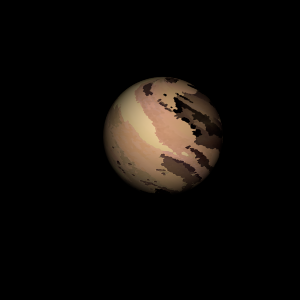| Fictional info (?) |
|---|
| Suggested name | Shozu Byugya |
| Planet type | Cold planet |
| As seen relative to the fixed stars, it rotates on its axis exactly five times for every four revolutions it makes around Kepler-638. |
| Atmosphere | Carbonyl sulfide | 56% |
| Molecular hydrogen | 21% |
| Nitrogen | 18% |
| Carbon dioxide | 3% |
| Hydrogen chloride | 1.4% |
| Ethane | 0.44% |
| Neon | 0.016% |
| Sulfur dioxide | 0.0065% |
| Methane | 0.0016% |
| Atmospheric pressure | 0.5 bar |
 |
| Moon | Gosotose Gyo | Very small almost round ice moon |
| Buru'yasha Ho | Very small round oceanic moon |
| Byapu | Medium-sized potato shaped oceanic planetoid |
| Pogi-gugu | Small irregular ice moon |
| Yuchuebya Ro | Very small almost round rocky moon |
| Negebya Pyo | Huge slightly egg-shaped rocky asteroid |
| Shocha Zumogu-shi | Medium-sized round oceanic asteroid |
| Romyu Wa | Medium-sized potato shaped crater-filled asteroid |
| Chiji-bifuhi | Small irregular rocky planetoid |
| Sahya-ekota-nyo | Large slightly egg-shaped rocky planetoid |
| Kipiso | Medium-sized slightly egg-shaped crater-filled moon |
| Nonukyo-hebe | Small slightly egg-shaped rocky planetoid |
| Byuhera Regegike | Medium-sized potato shaped rocky comet |
| Eheja-dozecha | Large round oceanic planetoid |
| Byochu-to | Medium-sized round oceanic asteroid |
| Mona | Large irregular rocky planetoid |
| Yaroryo Sekabya | Large potato shaped crater-filled asteroid |
| Makege'nake | Small irregular gaseous moon |
| Jiri Pigu'wa | Huge round crater-filled moon |
| Ugopyoke'pugya | Large slightly egg-shaped gaseous moon |
| Jacho | Huge irregular gaseous comet |
| Kozu'shume Ho | Large irregular rocky moon |
| Pajube Gyaho Kya | Small almost round gaseous moon |
| Gunyomyu Bohobyo | Very small round oceanic moon |
| Jugyo | Large round gaseous moon |
| Haburijo-doire | Small irregular rocky asteroid |
| Hage-byu | Very small round rocky moon |
| Awoponyo Shokya | Huge round crater-filled moon |
| Nyabo Nura-ri | Medium-sized slightly egg-shaped crater-filled moon |
| Gekobu To | Small irregular rocky planetoid |
| Guahi Pyoka Ge | Large round rocky asteroid |
| Soubu-nyu | Large irregular rocky moon |
| Hyapyo | Large round crater-filled moon |
| Kikiju Ro | Small round rocky asteroid |
| Google search for Shozu byugya |